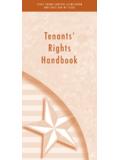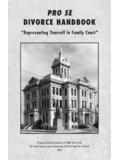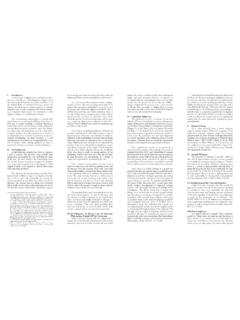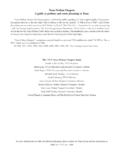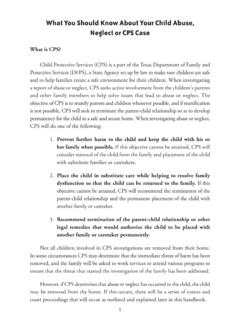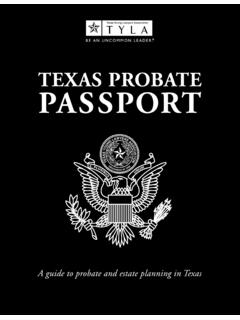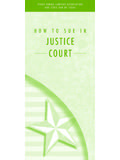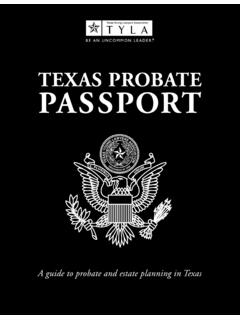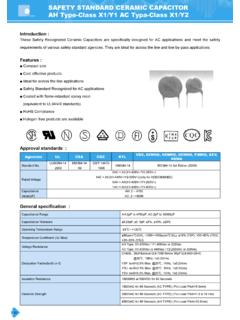Transcription of V. Requirements s up or t isbj ec nm q ah.I fy l A. …
1 I. IntroductionYour client has just received a subpoena from a Texas civilcourt in a case in which she is not a party. She calls youand inquires about what her legal obligations are. Haveyou received a similar call? If so, then you have come to theright place. TYLA has created this guide to assist Texaslawyers in advising their clients about what subpoenas are,their duty to respond, and how best to respond to a sub-poena issued to them by a Texas state or federal civil DefinitionA subpoena is an order from a court that commands a personor entity to appear in person or to produce documents at arequired place and time. Subpoenas are issued to persons orentities that are not parties to a lawsuit by the court withjurisdiction over: (1) the person or entity that is to testify; (2)the person or entity that is the custodian of the documentsthat are to be produced, or (3) the person or entity that pos-sesses the property that is to be inspected in a particular rules governing subpoenas, and the responses thereto,differ slightly based upon whether the case is criminal or civiland whether the case is in Texas state or federal court.
2 III. The RulesIV. Purpose In civil cases, subpoenas may be issued for purposes of dis-covery ( discovery subpoena ) or used to require a person totestify or produce documents at a hearing or trial ( trial sub-poena ). A discovery subpoena is used to secure documents( subpoena duces tecum ) or sworn testimony ( subpoenaand testificandum ) during the applicable discovery single subpoena can command a witness to both testifyand produce documents. If the subpoena calls for the production of documents only, then the witness need notappear at the time and place of production. TEX. R. (c); FED. R. CIV. P. 45(c)(2)(a). A discovery sub-poena cannot be used to circumvent the discovery R. CIV. P. (b), cmt. 2; FED. R. CIV. P. 26(b). From a practical perspective, you should contact the attorneyissuing the subpoena ( issuing attorney ) to understand whatdocuments she is particularly interested in, why the docu-ments are needed, or why your client s testimony is discussion with the issuing attorney may help narrowthe scope of the subpoena and thereby minimize any undueburden and expense to your client whom you may have oth-erwise advised to serve objections, file a motion to quash,modify, or for protection.
3 If you reach an agreement with theissuing attorney that limits the scope of the subpoena orreleases your client from her obligations under the subpoena,you should send a letter memorializing the agreement. V. Requirements A. Form and ContentsEvery subpoena issued by a Texas court must adhere to theform prescribed in the applicable rules. SeeTEX. R. , FED. R. CIV. P. 45. A subpoena issued in a state case must be issued in thename of The State of Texas and:(a) state the style of the suit and its cause number;(b) state the court in which the subpoena is pending;(c) state the date on which the subpoena is issued;(d) identify the person to whom the subpoena isdirected;(e) state the time, place, and nature of the actionrequired by the person to whom the subpoena isdirected, as provided in TEX. R. CIV. P. ;(f) identify the party at whose instance the subpoenais issued, and the party s attorney of record, if any;(g) include the text of TEX. RULE OF CIV. (a)2; and (h) be signed by the person issuing the subpoena issued in a state case must also command the per-son to whom it is directed to do either or both of the follow-ing: (a) attend and give testimony at a deposition, hearing, ortrial; (b) produce and permit inspection and copying of desig-nated documents, or tangible things in the possession, cus-tody, or control of that person.
4 TEX. R. CIV. P. A subpoena issued in a federal suit is similar to one issuedin a state case. The subpoena must: (a) state the court from which it is issued; (b) state the title of the action, the court in which theaction is pending, and its civil-action number;and set out the text of the rule.(c) include the text of FED. R. CIV. addition, the subpoena issued in a federal case mustcommand the person to whom it is directed to do the fol-lowing at a specified time and place: (a) attend and testify;(b) produce designated documents, electronically storedinformation, or tangible things in that person s possession,custody, or control, or (c) permit the inspection of R. CIV. P. 45(a)(1)(A)(iii).B. Geographical Limitations In state court, a subpoena can commend a witness toappear or produce documents in any county within 150miles of where the witness residesor was served. TEX. P. 176. For example, a subpoena issued by an attor-ney representing a party in an Amarillo civil case may com-pel a witness who lives or is served in Houston to appearfor deposition or produce documents in Houston (or with-in 150 miles of Houston).
5 However, that subpoena cannotcompel the Houston resident witness to give a depositionor produce documents in Amarillo (unless the Houstonresident witness is served within 150 miles of Amarillo). A subpoena requiring a witness to appear for a hearing ortrial in state court is slightly different than a subpoena for adeposition or documents only. A witness must appear fortrial or hearing in the county of suit if the witness residesor was served within 150 miles of that county. TEX. & REM. CODE For example, a subpoenaissued by an attorney representing a party in a TarrantCounty suit can compel a witness who resides or is servedin Dallas County to appear for trial or hearing in TarrantCounty. That subpoena could not, however, compel a witnesswho resides or served in El Paso to attend the trial or hearingin Tarrant a federal court, a subpoena may be served at any place inthe that is: (a) within the district of the issuing court;(b) outside of the court s district, but within 100 miles of theplace for the deposition, hearing, trial production, or inspec-tion; (c) within the state of the issuing court if a state statuteor court rule permits a state court to serve a subpoena; or(d) in a place that the court authorizes on motion and forgood cause, if provided by federal statute.
6 FED. R. CIV. (b)(2). Note that subpart (c) makes the range limitsapplicable to service of Texas state subpoenas applicable tofederal subpoenas as well. There are also rules for issuingand serviced a subpoena to a national or resident whois in a foreign country that are not discussed here. FED. P. 45(b)(3); 28 Who May Issue and ServeIn state court, a subpoena must be issued by the appropriatecourt clerk, an attorney authorized to practice in Texas, or adeposition officer authorized to take depositions in the R. CIV. P. In federal court, the appropriate district clerk must issue ablank signed subpoena, and the party requesting the sub-poena must complete it. FED. R. CIV. P. 45(a)(3). It isimperative that the attorney obtains the subpoena fromthe appropriate court. A subpoena for a witness to attend ahearing or trial must be issued from the district courtwhere the hearing or trial will be held. FED. R. CIV. (a)(2)(A). A subpoena for a deposition must be issuedfrom the court where the deposition is to be taken.
7 CIV. P. 45(a)(2)(B). A subpoena duces tecum (notaccompanying a subpoena for attendance) must be issuedfrom the court where the production, inspection, copying,testing or sampling of documents or electronically storedinformation will be made. FED. R. CIV. P. 45(a)(2)(C). Asubpoena may also be issued and signed by an attorney asan officer of: (a) the court where the attorney is authorized topractice; or (b) a court where a deposition is to take placeor a production is to be made, if the attorney is authorizedto practice in the court where the action is pending. CIV. P. 45(a)(3)(B).In state and federal cases, a subpoena may be served byanyone who is not a party and at least 18 years old. CIV. P. ; FED. R. CIV. P. 45(b).VI. Objections, Motions, and Response Whether the subpoena is issued from state or federal court,your client must do one or more of the following: (1) servingobjections; (2) filing a motion to quash or modify the sub-poena or for protection from compliance; or (3) simplycomplying with the terms of subpoena, unless the obligationto respond is discharged by the court or the issuing burden of proof is on your client to have evidence tosupport its objections or motion to quash.
8 If your client failsto respond to the subpoena without an adequate excuse, thenshe may be held in contempt of court and may be fined, putin jail, or both. TEX. R. CIV. P. ; FED. R. CIV. P. 45(e). In state court, the subpoena may be challenged by the personwho is the subject of the subpoena, the parties, or any otherperson affected by the subpoena. TEX. R. CIV. P. (d)-(f). A person who receives a discovery subpoena (for testi-mony or documents) may simply comply; or object, move toquash, modify, or seek protection from the court in writingbefore the time specified for compliance in the R. CIV. P. Conversely, a person who receivesa trial subpoena ( , subpoena for a witness to testify orproduce documents at a hearing or trial), may object ormove for protection at the time and place specified in thesubpoena. TEX. R. CIV. P. (f).Like state court, a subpoena issued in federal court may bechallenged by any person who is subject to or affected bythe subpoena. FED. R. CIV. P. 45(c)(2)(B), (3)(B).
9 In fed-eral court, the timeline for objections to a subpoena differsslightly from state court. In federal court, objections mustbe served within 14 days after service of the subpoenaor before the time specified for compliance, whicheveris sooner. Fed. R. Civ. P. 45(c)(2)(B). A motion to quash,modify, or for protection must be filed timely. Fed. P. 45(c)((3)(B). In general, the motion should be filedas soon as possible if an agreement cannot be reached withthe issuing attorney, and certainly no later than the earlierof (a) the time specified for compliance or (b) within 14 daysafter service of the subpoena. A. ObjectionsIn state and federal court, all objections must be in writingand served on the issuing attorney. Objections can bemade to both the form and substance of the can be made by the person subject to the sub-poena, a party, or any other person affected by the subpoenaand must be served within the time period referencedabove. A witness receiving a subpoena need not complywith the part of the subpoena to which an objection ismade unless required to do so by court order.)
10 TEX. P. (d); FED. R. CIV. P. (c)(2)(B). The tablebelow is a non-exhaustive list of possible objections. Moreover, in both state and federal court, a witness subjectto a subpoena may assert any applicable privilege to anywritten discovery in the same manner as that of a party tothe suit. SeeTEX. R. CIV. P. , ; TEX. R. et seq; FED. R. CIV. P. 26(b)5, 45(d)(2); FED. R. et seq. Note that if you are withholding privileged docu-ments requested by a Texas state subpoena, you must includea withholding statement as required by TEX. R. CIV. (a). In federal court (and in Texas state court aftermaking a withholding statement and receiving a request),you must provide a privilege log that includes informationsufficient to allow the requesting party to evaluate the appli-cability of the claimed privilege or production. SeeFED. P. 26(b)(5)(A); TEX. R. CIV. P. (b).B. Motion to Quash, Modify, or for ProtectionA witness served with a subpoena, or any other affected per-son, may move the court to quash or modify the subpoena1 This pamphlet is intended as an overview and guide to Texas attorneys and notas a substitute to reading the actual rules or case law regarding subpoenas.
